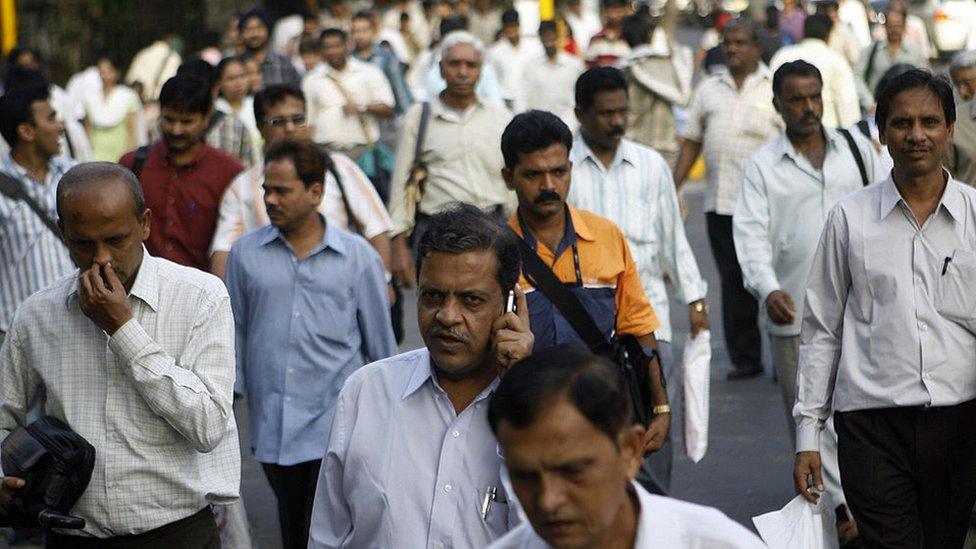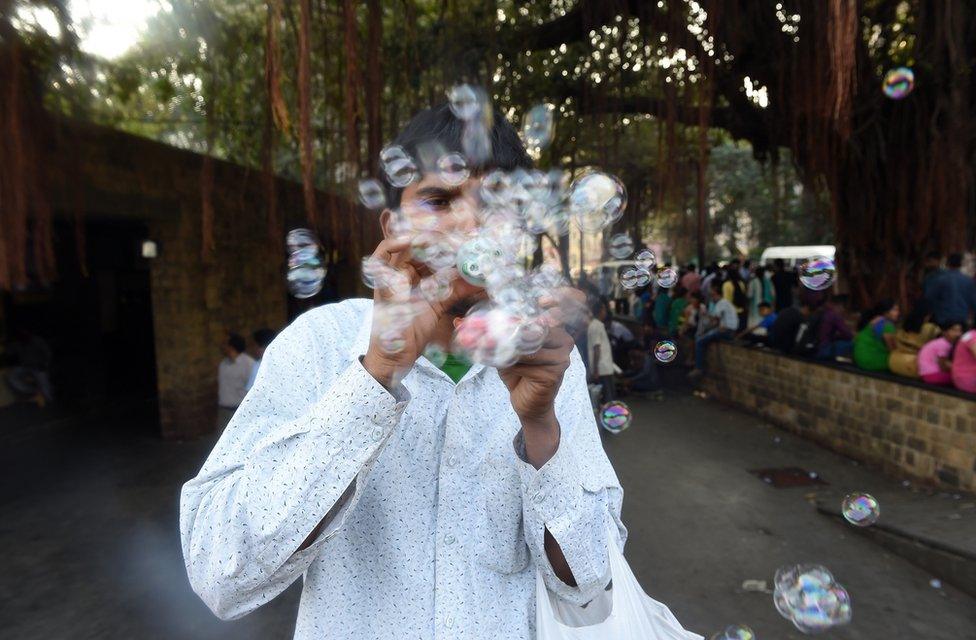Is India's middle class actually poor?
- Published

A new study says more than 600 million Indians belong to the middle class
Never before in recorded history, wrote author Gurcharan Das, have so many people been in a position to rise so quickly.
He was alluding to the rise of India's "new middle class", full of energy and drive and making things happen in an "uninhibited, pragmatic and amoral fashion". They also comprise an exploding consumer market that McKinsey Global Institute in 2007 described as India's "bird of gold", external.
The reality, of course, is more sobering.
For one, what has never been completely clear is the size of India's middle class.
Depending on how you calculate it, economists estimate between 10 and 30% of Indians are middle class. A curious outlier is a 2012 federal government exercise that counted citizens paying income tax - 29 million - as middle class.
Riddle
Personal and household income thresholds have been regularly used to define the middle class. Over a period of time as an economy grows richer and personal incomes increase, a lot of people usually move up and cross the threshold and join the middle class.
But a couple of new studies are now shedding more light on the riddle of India's middle class.
In their paper, economists Sandhya Krishnan and Neeraj Hatekar conclude that 600 million people, or more than half of India's population, belong to the middle class., external

The 'new' middle class is fuelled by the expansion of the poor who have moved up
But wait. This is not a middle class that entirely conveys a lifestyle associated with cars, washing machines, computers and credit cards.
The economists have used an income threshold that defines middle class people as those living on between $2 (£1.52) to $10 per person per day, valued at 1993 purchasing power parity (PPP) dollars. (Purchasing power parity enables you to compare how much you can buy for your money in different countries.)
They have broken down the middle class into two - the lower middle (living on $2-$4 per person per day) and upper middle (living on $6-10 per person per day).
Using this threshold, Ms Krishnan and Dr Hatekar have found that the new middle class is more diverse - traditionally, the Indian middle class has been dominated by the upper castes.
They argue that the lower middle class has fuelled the increase in numbers. A large number of them are engaged in jobs like farming and construction that the poor have traditionally done. Now they make up, according to the study, more than two-thirds of the middle class.
"The composition and character of the new Indian middle class is indeed unique because it now has people who are typically not considered to be belonging to the middle class," Ms Krishnan and Dr Hatekar told me in an email interview.
"These include the informal sector workers such as construction workers and people from the disadvantaged caste groups. Most importantly, we need to understand that the conventional idea of the middle class- of the educated, upper-caste groups - does not hold true anymore."
It is also true, they agree, the new middle class is vulnerable to falling back into poverty in the event of an economic shock.

India's rising upper middle class has substantial disposable income
The ongoing economic slowdown may have already hurt many of them, as jobs are lost and wages shrink in sectors like construction.
Anirudh Krishna, a professor of public policy and political science at US's Duke University, believes the latest findings show a considerable expansion of the middle class only because it has included a vast number of the near-poor and still-vulnerable people.
He reckons that if you calculate India's middle class by setting its lower threshold at $10 per person a day, then less than 2% of Indians actually have the status.
But if you set the lower income threshold at $2 per person per day, then the middle class count would swell to include maids and drivers, security guards and construction workers, indeed almost anyone who is gainfully employed.
Aspirational
Dr Krishna says "freedom from vulnerability and a real chance of upward mobility" are what truly define the middle-class existence.
"That's why people who are not in it aspire to be in the middle class. There's an aspirational element to middle-class; it's not simply a mathematical construct and a sociological cipher. It's not clear that many aspire to be maids or construction labours - or whether these people regard their own existence as a middle class one," he told me.
The aspirational element, external is what a second new paper by Devesh Kapur, Neelanjan Sircar and Milan Vaishnav sets out to explore.
They asked nearly 70,000 Indians, living in cities and villages, whether or not they would describe themselves as middle class.
The authors chose something as subjective as self-identification as a way of measuring middle class given the "inconclusive debate over the use and abuse of objective measures of class belonging".

There are concerns whether there is enough quality education to match the growing demand
The study found that almost half of the respondents - between 40 and 60% - across two dozen states and across all ages and all income and social groups, identified themselves as middle class.
To be true, most Indians in cities and towns called themselves middle class compared to people living in villages, where nearly 70% of Indians live.
But even 45% of low income respondents identified themselves as middle class - just 3% less than the richest income group.
The respondents were also asked questions relating to their children's social mobility, improvement in their family's social status, their country's overall progress, economy, and the economic condition of their households.
The authors found that all the people who identified themselves as middle class were "more optimistic - both about the status of their lives today as well as the prospects for the future.
Clearly, the self-declared Indian middle-class appears to be bullish about the future despite mounting evidence of lack of jobs, rising inequality and stagnant - and even falling, external - wages.
Status conscious
The findings, say the authors, raise several questions.
For one, is middle class a "status marker" that the poor aspire to in a status conscious society?
Or, more importantly, is the validity of the measure "itself an issue since respondents across language groups might have interpreted the question in different ways?
Whatever is the case, the two studies make clear a few things.
One, India's aspirational middle-class, as Devesh Kapur, Neelanjan Sircar and Milan Vaishnav say, "may be less ideologically driven and instead more focused on gaining social and economic status in a country where there is tremendous amount of churn taking place".

Millions of unskilled young people enter India's workforce each year
Two, how this middle class votes will reflect aspirations of upwardly mobility, so better governance and more jobs will be increasingly more important to this group than traditional caste and identity-based politics.
Research has shown that the middle class backed Narendra Modi's BJP in large numbers during the 2014 general election because the party offered a strong narrative of hope.
But as the both the authors of the studies say, middle class support cannot be taken for granted by any government and failure to deliver on governance and jobs will easily lead them to switch loyalties.
Even if the jury is out on the number of people who would qualify to be middle class in India, what is clear is that large numbers of people now have the ability of making small investments for the future - start a business, provide their children with better education, ensure clean drinking water and give them enough to eat.
But this is easier said than done. "The concern is whether there is good enough supply of real business opportunities or really good quality education to match that growing demand," Abhijit Vinayak Banerjee, a professor of economics at MIT told me. "Moreover the worsening environment is making it harder to bring up healthy children". Until things improve further, the new Indian middle class will remain fragile.